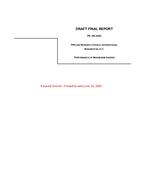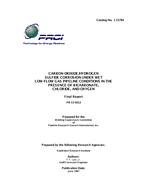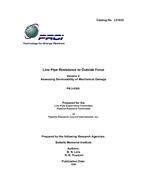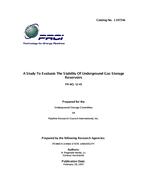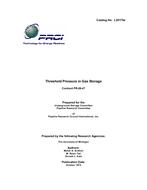Provide PDF Format
PRCI PR-186-0025
- Development of Quality and Performance Specifications For Magnesium Anodes
- Report / Survey by Pipeline Research Council International, 05/27/2003
- Publisher: PRCI
$148.00$295.00
L51886e
CC Technologies Laboratories, Inc.
Need: Magnesium anodes are provided to the corrosion control industry by a number of domestic and international manufacturers and distributors. Due to the difficulty and time involved in performance testing, anode composition is commonly the only criterion used for quality control by the end users. However, experience has shown that compliance of the anode chemical composition with the ASTM B843 Standard Specification for Magnesium Alloy Anodes for Cathodic Protection can be misleading and does not always differentiate between the anodes of different quality. Thousands of magnesium anodes are produced annually and provided by a number of suppliers to the corrosion control industry. Though the composition of the anodes from the various sources is comparable, the performance of the magnesium anodes is often radically different. Many of these materials have been shown to meet the compositional and potential specifications, and yet have had measured efficiencies as low as 7%.
Result: The objectives of this project were: (1) to develop quality and performance standards determined by laboratory tests and field exposures. The project included testing a variety of anodes submitted by the manufacturers/distributors and the end users, representing all spectrum of the ASTM G97 Standard Test Method-based efficiency values; the anodes were characterized with respect to the Anode source, manufacturing process, macrostructure, chemical composition, anode type ("standard"/H-1 family /AZ63 family versus "high-potential"), and microstructure. Other investigations comprised assessment of the ASTM G97 Standard Test Method parameters that were most likely to make the most significant impact on the resulting anode efficiency values, e.g., testing environment ("standard" testing solution and saturated backfill), and current density (the low 1/10th of the standard'), the ASTM G97 standard, and the high (10X standard) values). Testing in saturated backfill was used for a comparison between the laboratory- and the field-based efficiencies.
Benefit: Laboratory-based testing was augmented by extensive field-based evaluations (over a span of 12 or more months). A total of 20 anodes were tested in the field. (8 anodes in Central Michigan, 4 in Southern Michigan, 4 in Southern Colorado, 2 in Southern Kentucky, and 2 in Central Ohio); upon completion of the exposure, the anodes were retrieved and each anode's current discharge efficiency was determined. The ASTM G97 Standard Test Method was reviewed in light of the results of the experimental program to determine if any changes to the testing procedure could be recommended or if there is a possibility to introduce an alternative anode evaluation protocol.
CC Technologies Laboratories, Inc.
Need: Magnesium anodes are provided to the corrosion control industry by a number of domestic and international manufacturers and distributors. Due to the difficulty and time involved in performance testing, anode composition is commonly the only criterion used for quality control by the end users. However, experience has shown that compliance of the anode chemical composition with the ASTM B843 Standard Specification for Magnesium Alloy Anodes for Cathodic Protection can be misleading and does not always differentiate between the anodes of different quality. Thousands of magnesium anodes are produced annually and provided by a number of suppliers to the corrosion control industry. Though the composition of the anodes from the various sources is comparable, the performance of the magnesium anodes is often radically different. Many of these materials have been shown to meet the compositional and potential specifications, and yet have had measured efficiencies as low as 7%.
Result: The objectives of this project were: (1) to develop quality and performance standards determined by laboratory tests and field exposures. The project included testing a variety of anodes submitted by the manufacturers/distributors and the end users, representing all spectrum of the ASTM G97 Standard Test Method-based efficiency values; the anodes were characterized with respect to the Anode source, manufacturing process, macrostructure, chemical composition, anode type ("standard"/H-1 family /AZ63 family versus "high-potential"), and microstructure. Other investigations comprised assessment of the ASTM G97 Standard Test Method parameters that were most likely to make the most significant impact on the resulting anode efficiency values, e.g., testing environment ("standard" testing solution and saturated backfill), and current density (the low 1/10th of the standard'), the ASTM G97 standard, and the high (10X standard) values). Testing in saturated backfill was used for a comparison between the laboratory- and the field-based efficiencies.
Benefit: Laboratory-based testing was augmented by extensive field-based evaluations (over a span of 12 or more months). A total of 20 anodes were tested in the field. (8 anodes in Central Michigan, 4 in Southern Michigan, 4 in Southern Colorado, 2 in Southern Kentucky, and 2 in Central Ohio); upon completion of the exposure, the anodes were retrieved and each anode's current discharge efficiency was determined. The ASTM G97 Standard Test Method was reviewed in light of the results of the experimental program to determine if any changes to the testing procedure could be recommended or if there is a possibility to introduce an alternative anode evaluation protocol.
Related Products
PRCI PR-15-9313
CO2/HS Corrosion Under Wet Low-Flow Gas Pipeline Conditions in Presence of Bicarbonate, Chloride, &a..
$298.00 $595.00
PRCI PR-003-9305
Line Pipe Resistance to Outside Force: Assessing Serviceability of Mechanical Damage..
$298.00 $595.00
PRCI PR-12-43
A Study to Evaluate the Stability of Underground Gas Storage Reservoirs..
$98.00 $195.00

